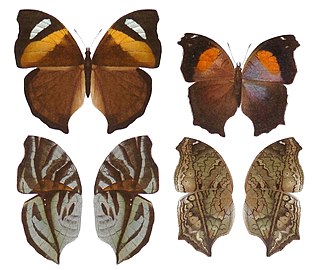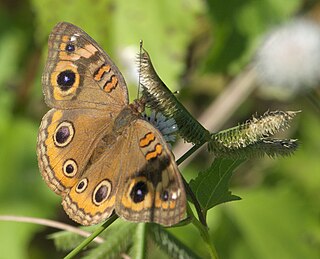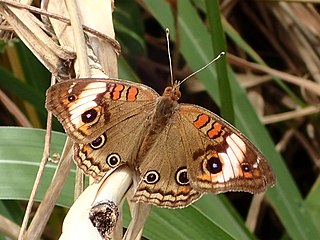
The Nymphalidae are the largest family of butterflies, with more than 6,000 species distributed throughout most of the world. Belonging to the superfamily Papilionoidea, they are usually medium-sized to large butterflies. Most species have a reduced pair of forelegs and many hold their colourful wings flat when resting. They are also called brush-footed butterflies or four-footed butterflies, because they are known to stand on only four legs while the other two are curled up; in some species, these forelegs have a brush-like set of hairs, which gives this family its other common name. Many species are brightly coloured and include popular species such as the emperors, monarch butterfly, admirals, tortoiseshells, and fritillaries. However, the under wings are, in contrast, often dull and in some species look remarkably like dead leaves, or are much paler, producing a cryptic effect that helps the butterflies blend into their surroundings.

The morpho butterflies comprise many species of Neotropical butterfly under the genus Morpho. This genus includes more than 29 accepted species and 147 accepted subspecies, found mostly in South America, Mexico, and Central America. Morpho wingspans range from 7.5 cm (3.0 in) for M. rhodopteron to 20 cm (7.9 in) for M. hecuba, the imposing sunset morpho. The name morpho, meaning "changed" or "modified", is also an epithet.

The superfamily Papilionoidea contains all the butterflies except for the moth-like Hedyloidea.

Junonia is a genus of nymphalid butterflies, described by Jacob Hübner in 1819. They are commonly known as buckeyes, pansies or commodores. This genus flies on every continent except Antarctica. The genus contains roughly 30 to 35 species.

The butterfly subtribe Euptychiina is a diverse group within the tribe Satyrini, occurring throughout Central and South America, in addition to a few species known from North America. Euptychiina is a predominantly lowland group, with the exception of one Asian taxon Palaeonympha opalinaButler, 1871 and the Andean genus ForsterinariaGray, 1973. The taxon was erected by Lee Denmar Miller.

Salamis is a genus of nymphalid butterflies. They are commonly known as mother-of-pearls and are found in Africa. Salamis was a nymph in Greek mythology, the daughter of the river god Asopus and Metope, daughter of the Ladon, another river god.

Biblis hyperia, the red rim or crimson-banded black, is a species of brush-footed butterfly that is native to the lower Rio Grande Valley of Texas in the United States, Mexico, the Caribbean, Central America, and South America as far south as Paraguay. Its genus Biblis is so far monotypic, but at least one other undescribed species is suspected to exist.

Junonia genoveva, the mangrove buckeye, is a butterfly of the family Nymphalidae. The species was first described by Pieter Cramer in 1780. It is found in South America, and possibly into Central America.

Pronophilina is a Neotropical subtribe of butterflies of the subfamily Satyrinae. They are a species-rich group with highest diversity in the tropical and subtropical mountains, especially the Andes. Before 1970, they were poorly studied, but recent interest has resulted in high rates of species description from previously unexplored mountain ranges. However, there is still a lack of knowledge on their biology and ecology. Their relationship to other groups of Satyrine butterflies and their complex patterns of speciation within and among mountain ranges have led to several biogeographic discussions.

Taygetis is a genus of satyrid butterflies found in the Neotropical realm.

Argyrophorus is a butterfly genus from the subfamily Satyrinae in the family Nymphalidae. It is distributed between Chile, Argentina and Perú. The systematic and circumscription of the genus is disputed.

Dynamine postverta, the Mylitta greenwing or four-spot sailor, is a butterfly in the family Nymphalidae. It is found throughout most tropical and subtropical areas of Central and South America, from Mexico south to Argentina and Paraguay. The habitat includes primary rainforests, humid deciduous woodlands, scrubby grassland and farmland at altitudes up to about 900 metres.

Napeocles jucunda, the great blue hookwing, is a South American butterfly of the family Nymphalidae. The species was first described by Jacob Hübner in 1808.

Junonia neildi, the West indian mangrove buckeye, is a species in the butterfly family Nymphalidae.

Junonia nigrosuffusa, the dark buckeye, is a species in the butterfly family Nymphalidae. It is found in the southwestern United States and Mexico.

Junonia zonalis, the northern tropical buckeye, is a species in the butterfly family Nymphalidae. It is found in Florida, the Caribbean, Mexico, Central America, and tropical South America. Junonia zonalis and Junonia nigrosuffusa were formerly subspecies of Junonia evarete, the tropical buckeye, but were elevated to the species rank as a result of phylogenetic and DNA research. As a result, the geographic range of Junonia evarete is limited primarily to South America.

Anaea are a genus of charaxine butterflies in the brush-footed butterfly family Nymphalidae. The butterflies are commonly known as leafwings. Members of the genus are found throughout the United States, Central America, and the Caribbean.

















